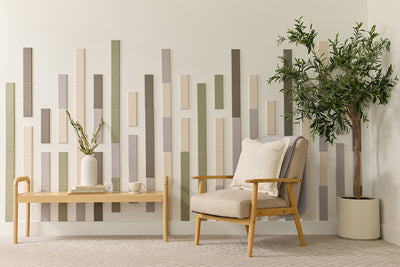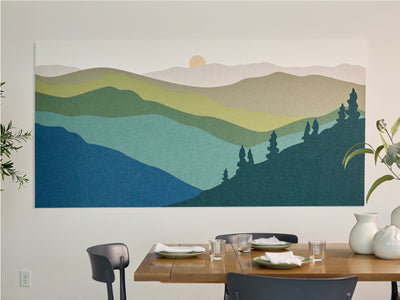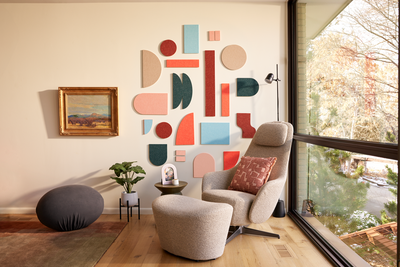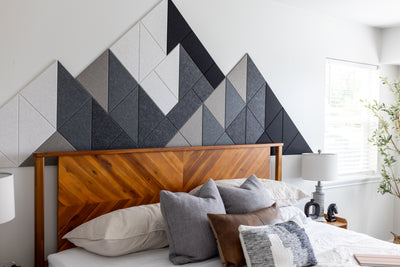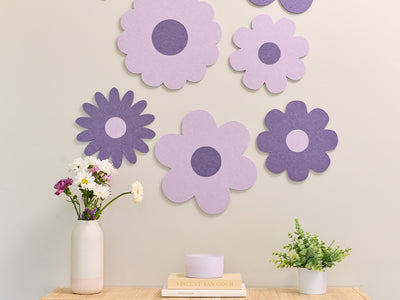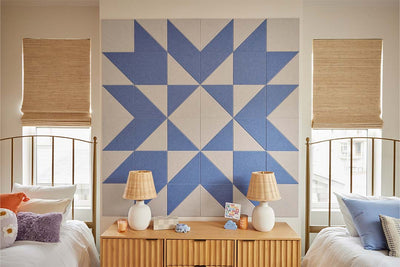Exploring Felt Right Patterns
Exploring Line Theory with Felt Right
An integral element of art and design, lines make up the shapes and patterns we see in our everyday lives. Different types of lines elicit different meanings and emotions. Understanding the main types of lines in art and design is crucial in order to use them intentionally based on their specific functions.
Felt Right is your industry leader for high-quality felt tiles and felt boards that will look amazing in your home, office, or any other interior space. Colorful and pinnable felt wall tiles can instantly provide texture, warmth, and color to your walls. With a wide array of colors, patterns, and felt tile designs, you can transform any wall in your home or office into a work of art within minutes. And with these acoustic panels for walls, these sound-dampening wall tiles can even help you control excess noise in your space.
Read on to learn more about line theory and how felt tiles can help you take advantage of the power of specific lines, shapes, and patterns.

Main Types of Lines and What They Represent
-
 Vertical lines move straight up and down in space. They suggest strength and fortitude and add height to a space.
Vertical lines move straight up and down in space. They suggest strength and fortitude and add height to a space. -
 Horizontal lines are parallel to the horizon, moving straight from left to right. In contrast to vertical lines, they represent width and stability.
Horizontal lines are parallel to the horizon, moving straight from left to right. In contrast to vertical lines, they represent width and stability. -
 Diagonal lines move straight in any direction except vertical and horizontal. They convey kinetic energy and movement.
Diagonal lines move straight in any direction except vertical and horizontal. They convey kinetic energy and movement. -
 Zigzag lines are composed of a series of diagonal lines that are joined at each end point. These types of lines are frenetic in nature and suggest excitement.
Zigzag lines are composed of a series of diagonal lines that are joined at each end point. These types of lines are frenetic in nature and suggest excitement. -
 Curved lines bend and change direction more gradually than zigzag lines. The lines convey ease and tranquility and remind us of nature and the human body.
Curved lines bend and change direction more gradually than zigzag lines. The lines convey ease and tranquility and remind us of nature and the human body.
How to Mindfully Select Patterns

Pattern and color work together harmoniously to create depth and dimension in your space. Like color, patterns can elicit emotional responses--even if only subconsciously. Repetition and structure in a pattern or design promote order and rhythm, whereas organic lines promote creativity and remind one of natural elements.
When mixing patterns, there are no steadfast rules. However, a balanced blend of varying scales, colors, textures, and lines is important for a successful design. Whatever the case, a room requires visual interest. Whether it’s apparent or more subtle, Felt Right has the shapes and colors available to help you create a stunning piece of art, an organizational pinboard, or a sound-absorbing installation.
Hive
This design blends geometry with fluidity; at first glance, the pattern may seem arbitrary, but the content and composition come together to create an intentional visual balance.


Black to White
With nearly perfect symmetry, this design is concrete in its visual presence and evokes an imposing strength and force with its focus on vertical lines.


Mid-Century
This design communicates a visually stunning rhythmic pattern and can utilize multiple colorways for a minimal look, a classic pattern, or even an optically illusive repeat.


The Five Universal Shapes
Renowned cultural anthropologist, Angeles Arrien, studied common symbols in art of all forms in order to determine the five basic shapes in all cultures and to develop her Preferential Shapes Test. Her studies suggest that there are specific meanings attributed to each basic shape, and that, “each shape symbolizes a specific inner and outer experience relevant to humankind” (p. 29, Arrien).
The Circle is the first universal shape and represents wholeness and completeness. This shape symbolizes individuality and independence; those striving for this trait require physical and emotional room to grow and develop. The Equidistant Cross represents relationship and connection. The integration of balance and the need for connection are important aspects of this symbol. The Spiral represents growth and evolution, touching on the significance of new perspectives gained by experience and trials. The Triangle represents visions and dreams and symbolizes the expression of pursuing goals and self-discovery. Finally, the Square represents stability, security, and strength.
Take the test for yourself at the link above; maybe your findings will guide you to your next Felt Right design!

Transform Your Space with Felt Right Felt Tiles
It’s truly amazing what lines, shapes, and patterns can do for your interior space. By using certain lines on your walls and overall decor, you can influence and alter the mood and atmosphere in your space.
Start curating your own approach to line theory for your home or office with Felt Right’s My Studio design tool. You can also check out our Designs page for color and design inspiration created by our very own in-house team of interior design experts and pattern enthusiasts.
Take advantage of the power of patterns by transforming your walls with Felt Right felt tiles today.

